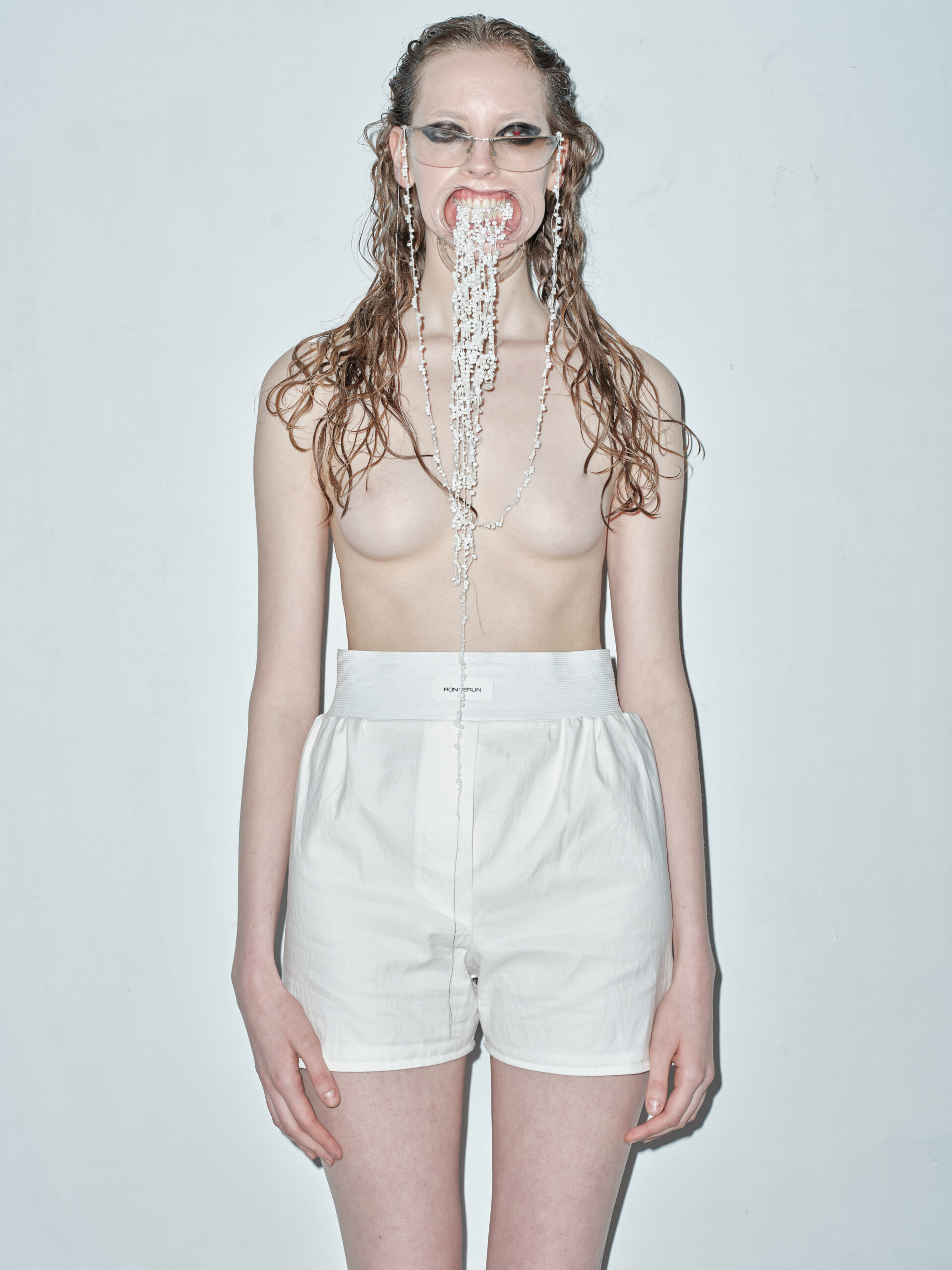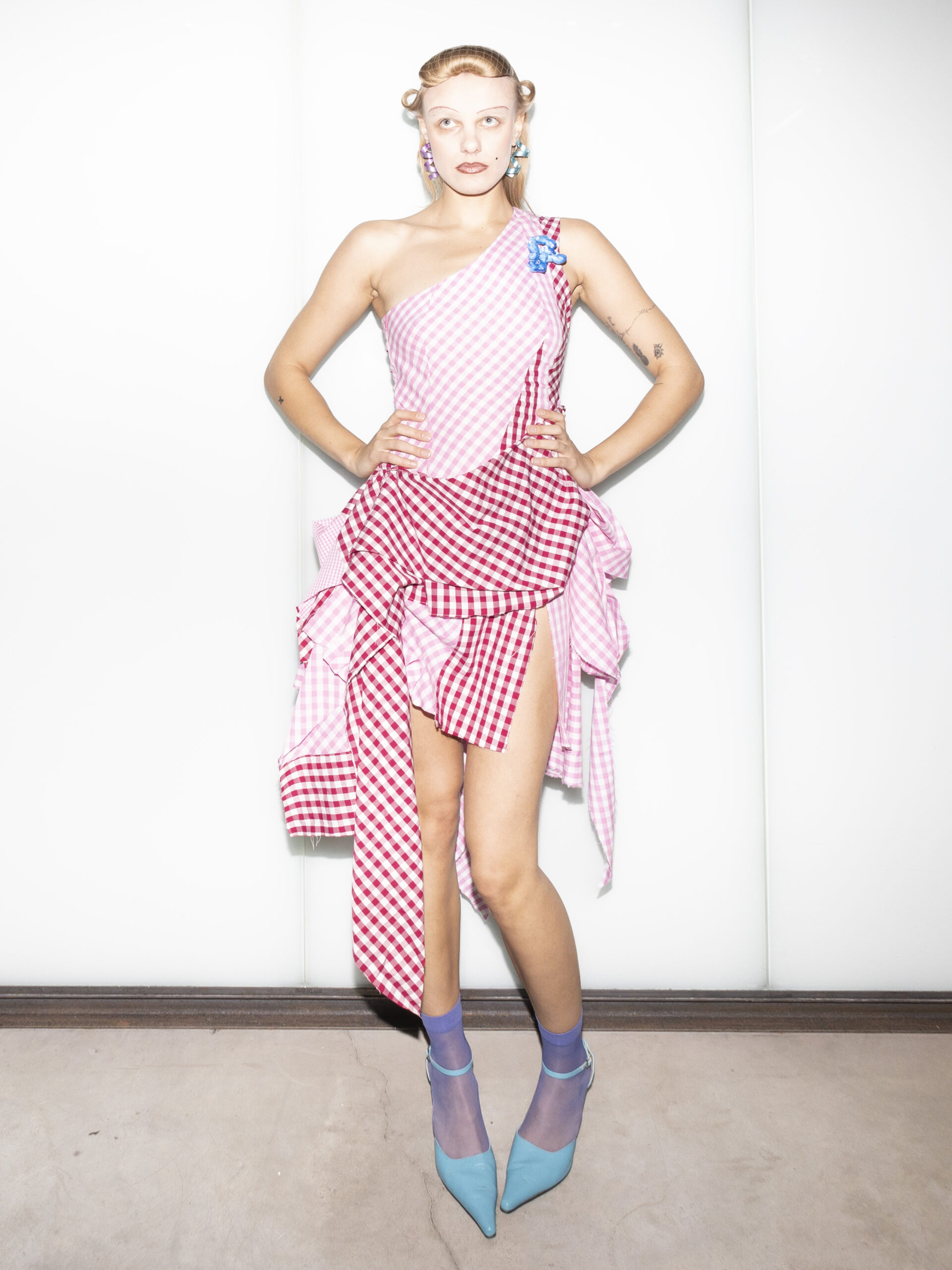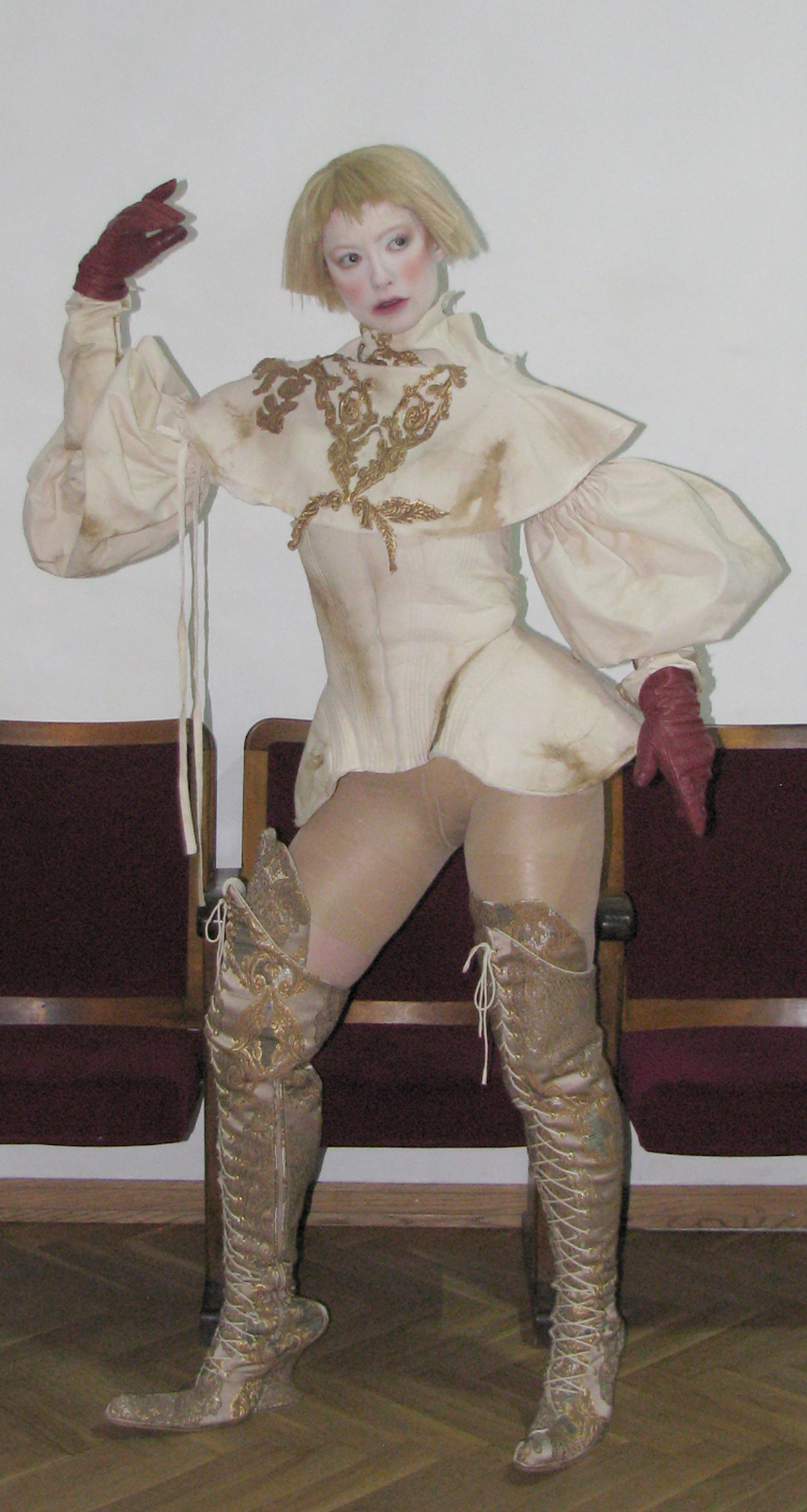
Young fashion designers in Estonia find themselves in a paradoxical situation. On one hand, experimentation and artistic approaches are stronger than ever, but on the other, the field lacks stable support – both institutionally and financially. Fashion design exists somewhere between design and art, yet it isn’t fully embraced by either. As a result, emerging designers scatter across different fields or seek opportunities abroad. Can fashion in Estonia ever establish itself as a vigorous, independent field?
In search of answers, Olivia Soans spoke to five young Estonian fashion designers: Karl Joonas Alamaa, Karl-Christoph Rebane, Maria Roosiaas, Lisette Sivard and Ron-Jonas Verlin. All of them have either graduated from or are currently finishing their studies in the fashion design department at the Estonian Academy of Arts (EKA). Now, they must face the question: How – if at all – should they continue as fashion designers in Estonia? They discuss cultural and financial struggles, reflect on the past and present role of Estonia’s most well-known fashion event, the ERKI Fashion Show, and share their creative perspectives – while also considering what the future holds for Estonian fashion.
Karl Joonas Alamaa: In Estonia, fashion remains an elusive thing. Some don’t take fashion seriously, others don’t understand it, and those who create it are kind of separated in their own corner. For some it’s design, for others it’s art. Beyond the lack of funding and support, there’s also the issue of fashion having no institutional centre in Estonia—no fashion museum, no unified organisation to nurture, develop, and support fashion culture. This is a field that lacks a cohesive structure, where everybody’s doing their own thing and these different directions don’t really align with each other.
Lisette Sivard: It seems to me that the Estonian fashion scene is fragmented and in quite a rough state. The opportunities for young designers are limited, and if anybody sticks around in Estonia’s fashion scene at all, then it’s mostly established designers who have been working for years. Emerging designers usually get attention when their work is worn by some celebrity. Currently, this seems to be the biggest achievement. Since financial prospects are bleak and employment opportunities are scarce, young designers are usually spread out somewhere between costume design and styling. I recently noticed that the fashion design department at EKA posts an Instagram story whenever one of its graduates gets a job. Of course, it’s nice when someone secures employment in their field, but right now, it almost feels like a celebration of the mere fact that anyone got hired – regardless of where or in what capacity. This gives the impression that “YESSSSS!! somebody got work!!! They’re employed; they get a salary each month! This field we’re teaching actually leads to employment!”
Karl-Christoph Rebane: It’s moving towards art. Young designers are making cool things, and are approaching it more artistically and deeper than before. However, as already mentioned, there’s not enough support in Estonia to make that sustainable. But there is some kind of general spirit. I haven’t had a sense for a long time now that there is much competition between people. I rather think that emerging fashion designers are held back by the fact that there’s no market.
Ron Verlin: I also feel that in recent years, there’s been some movement, but there’s not enough courage going around. If you make something that doesn’t fit the standards, you have to take into account that you’re going to face backlash in Facebook comments and elsewhere. But you shouldn’t be afraid of that.
Maria Roosiaas: In Estonia, fashion is seen more as a commodity than artistic expression, which makes working with more experimental fashion design difficult.
KJA: It’s difficult to compare the fashion scenes of Belgium and Estonia—Belgium is a wealthier country, providing fashion with a stronger foundation, and, as mentioned, they have the Antwerp Six. But beyond resources, people there seem more open-minded and knowledgeable about fashion.
One of the biggest differences is the institutional support, which is practically non-existent in Estonia. Antwerp has a dedicated fashion museum and a comprehensive fashion library, with a massive archive of garments and bookstores filled from floor to ceiling with fashion literature. And these are not just pretty coffee table books, but in-depth analytical works. But of course, you have to take into account the historical context. Belgium has been able to develop all this at a world-class level for the past 40 years, whereas in Estonia the cultural layer of fashion is thin, despite a long history of garment-making. If only the local history museum or the Estonian Museum of Applied Art and Design collected fashion design more actively and systematically… In Antwerp, the fashion museum is a centre for discourse in the field, and regularly acquires works from fashion designers who have studied or worked in Belgium. This demonstrates that they truly appreciate their students, alumni and fashion design as a whole. Sometimes it seems that in Estonia fashion is seen as a grey mass, that fashion is something that nobody’s willing to make a stand for – people invest either in traditional art or what’s more clearly design. But in the end, if you only water the cabbage that’s already growing, then other cabbages will never get the chance to grow. If you give a bit of water to the other cabbage as well, it will eventually also sprout.
LS: What also sets us apart from other countries is that most Estonian fashion designers come from a single university. That’s totally wild to think about. In Belgium there are more people and more schools, which leads to the formation of different schools of thought. In Estonia, a certified fashion designer can only come from the Estonian Academy of Arts – and since this community is so small, we all know each other as well. This could be our strength, something to unite and support us. But right now it seems to me that it’s not like that. I don’t know if it’s because of the lack of opportunities or simply because in Estonia everyone’s always competing. Karl-Christoph mentioned before that he doesn’t feel this competitiveness, but I have the feeling that our sense of unity isn’t as strong as it could be.
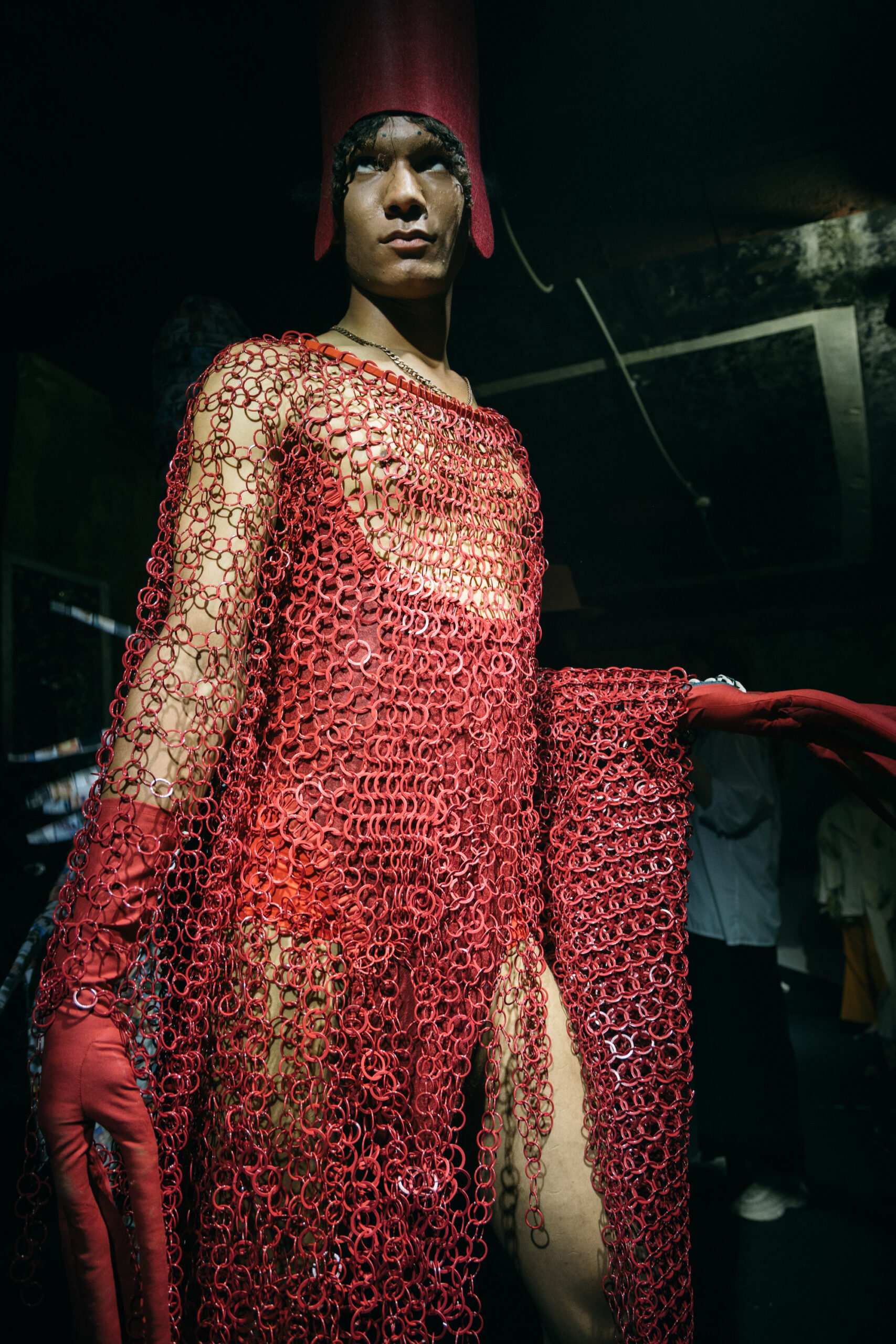
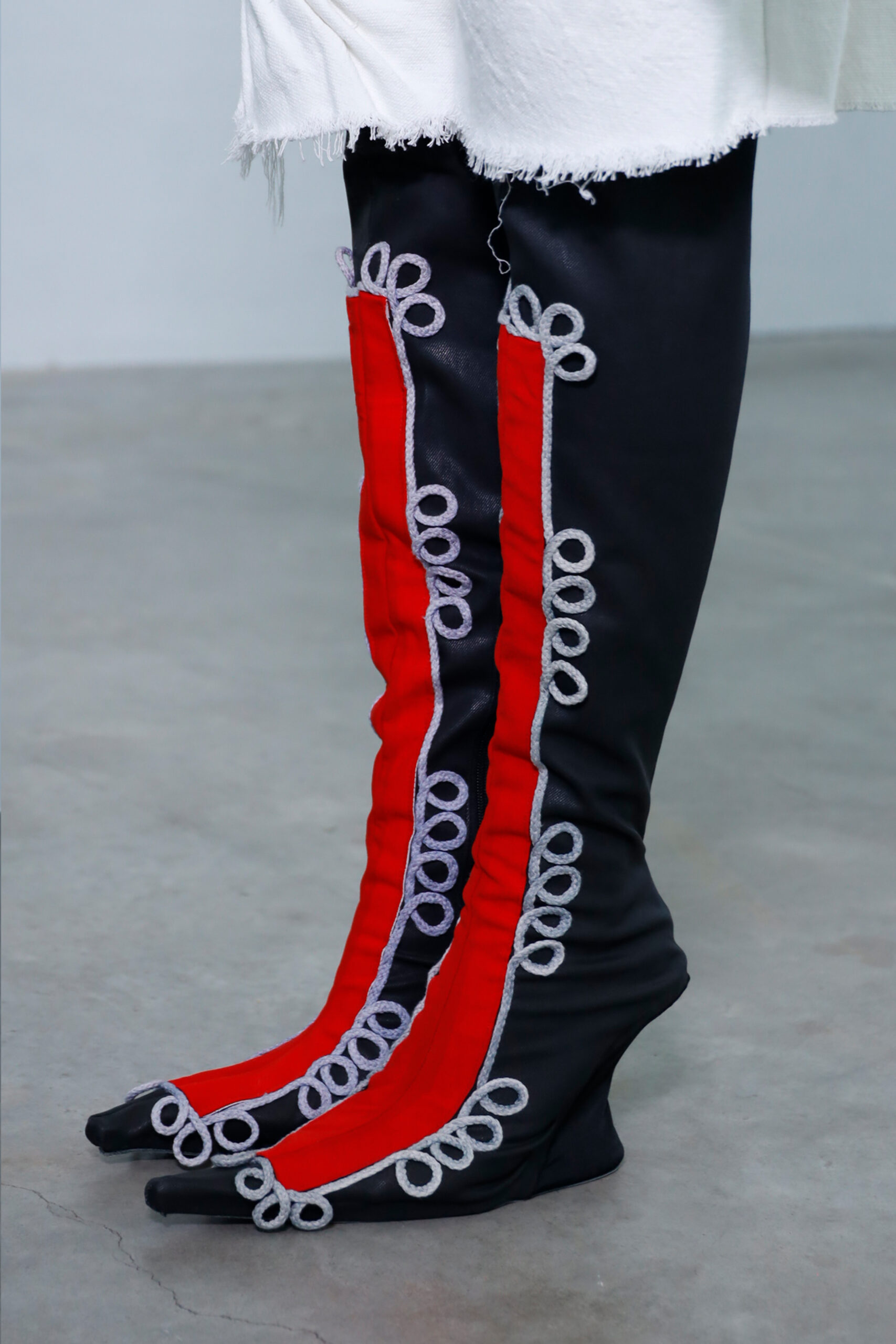
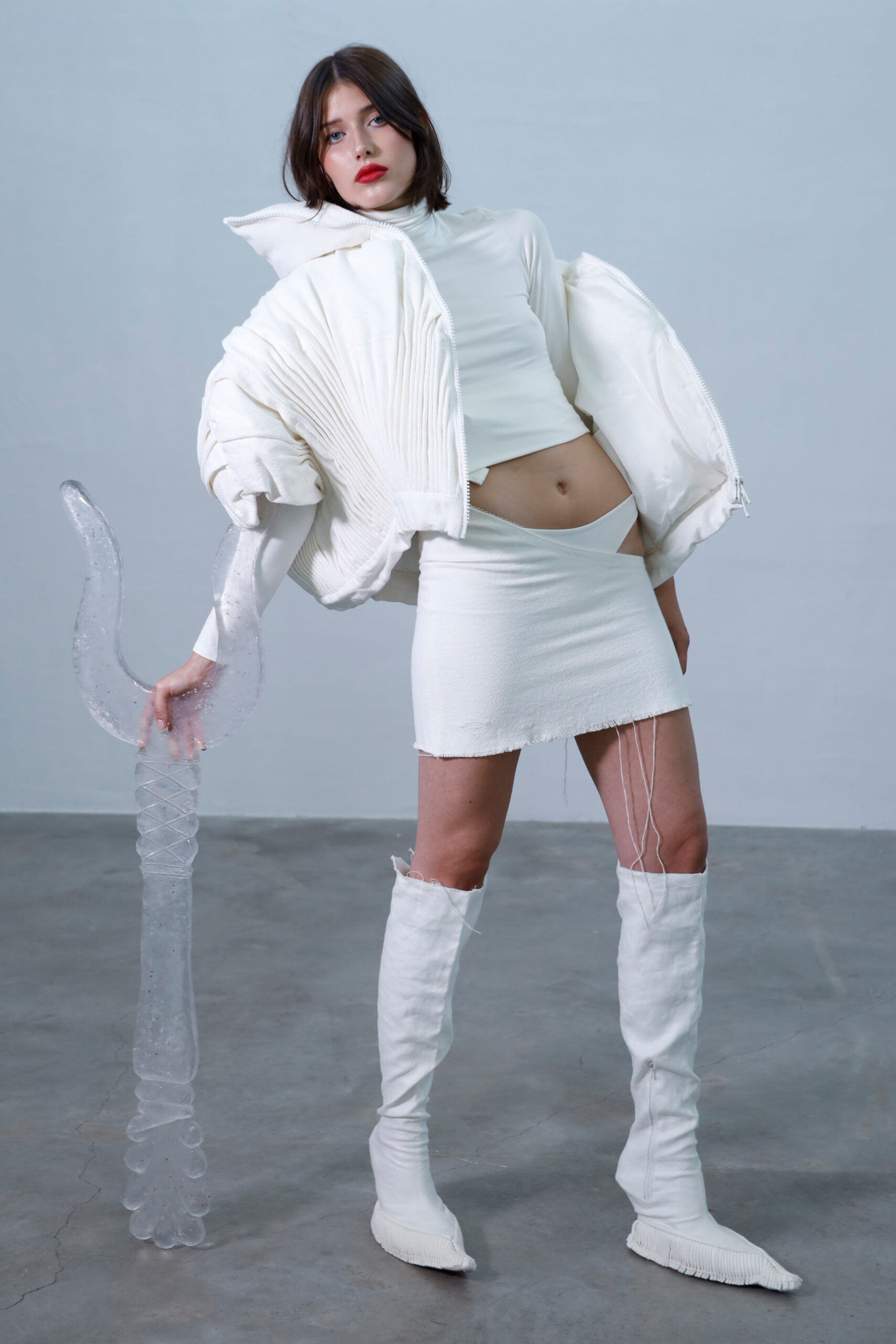
KCR: I have a quick answer – mental health. This is important for a creative person because you can lose yourself in your work in a way that you’re eventually unable to set boundaries for yourself. People spend hundreds of hours working on something, but afterwards get the feeling that it wasn’t worth it. My first collection, AM I A JOKE TO YOU (2019) was concerned with mental health, and stemmed from me not wanting to do military service.
RV: My work has always been connected to faith. Even the first project I did in EKA dealt with themes of faith: I used designs from my first collection in my graduation collection as well, creating a kind of full circle. During the years I have studied at EKA, I’ve come to understand that I have a strong character – I like to rebel. But I’ve never considered rebellion and faith as opposites, they co-exist in me.
MR: I wouldn’t say that I have a singular theme in my work, I'm more drawn to materials and the ways they can be manipulated. I rarely start with a clear message, I just experiment with materials, and it’s through this technical process that ideas start to take shape, giving the work its meaning.
With my bachelor’s thesis, for example, I drew inspiration from the climbing trees in my childhood, which inspired me to create a visual form. Of course, there are narratives and deeper layers in the work, but I don’t usually begin with a predefined concept.
LS: I’ve discovered that since the beginning of my studies I’ve been captivated by the theme of smallness. The feeling of being unnoticed, that you’ve been left out or neglected. This applies on a personal level but also in broader social and political contexts. Estonia is a small country and its position on the world map is constantly in question. In a similar way, the visibility of marginalised groups in society is an ongoing issue. How can we feel like we belong? Grief has also been a recurring theme in my work. For example, grief over what Estonia could’ve become or for what has never existed. When you live abroad, away from your home country, and see your culture from a distance, you begin to notice things that seemed to be self-evident before, but in truth are not. At the same time, it’s important for me to connect all of this with humour in some way. That creates a kind of friction. For example, right now for my master’s thesis, I’m exploring the idea of a uniform for professional mourners, a women’s mourning choir, but I want to merge it with the Spice Girls. So it ends up somewhere in between.
KJA: I’ve also noticed that the topics I work with have stayed fairly consistent over time, although of course they’ve also developed. In my work, history and the individual’s place in society have always been central. Looking back, even my first-year projects were strongly based on a historical context. I actually wanted to become a historian for a long time. But using this historical context has often been tied to a personal perspective, either related to my family or the cultural context I come from. Topics about the human condition have also been defining for me – everyday life and care, the individual and society. I’ve also always had sympathy for the collaborative approach. I believe that if genius really exists, then it is only within a group.
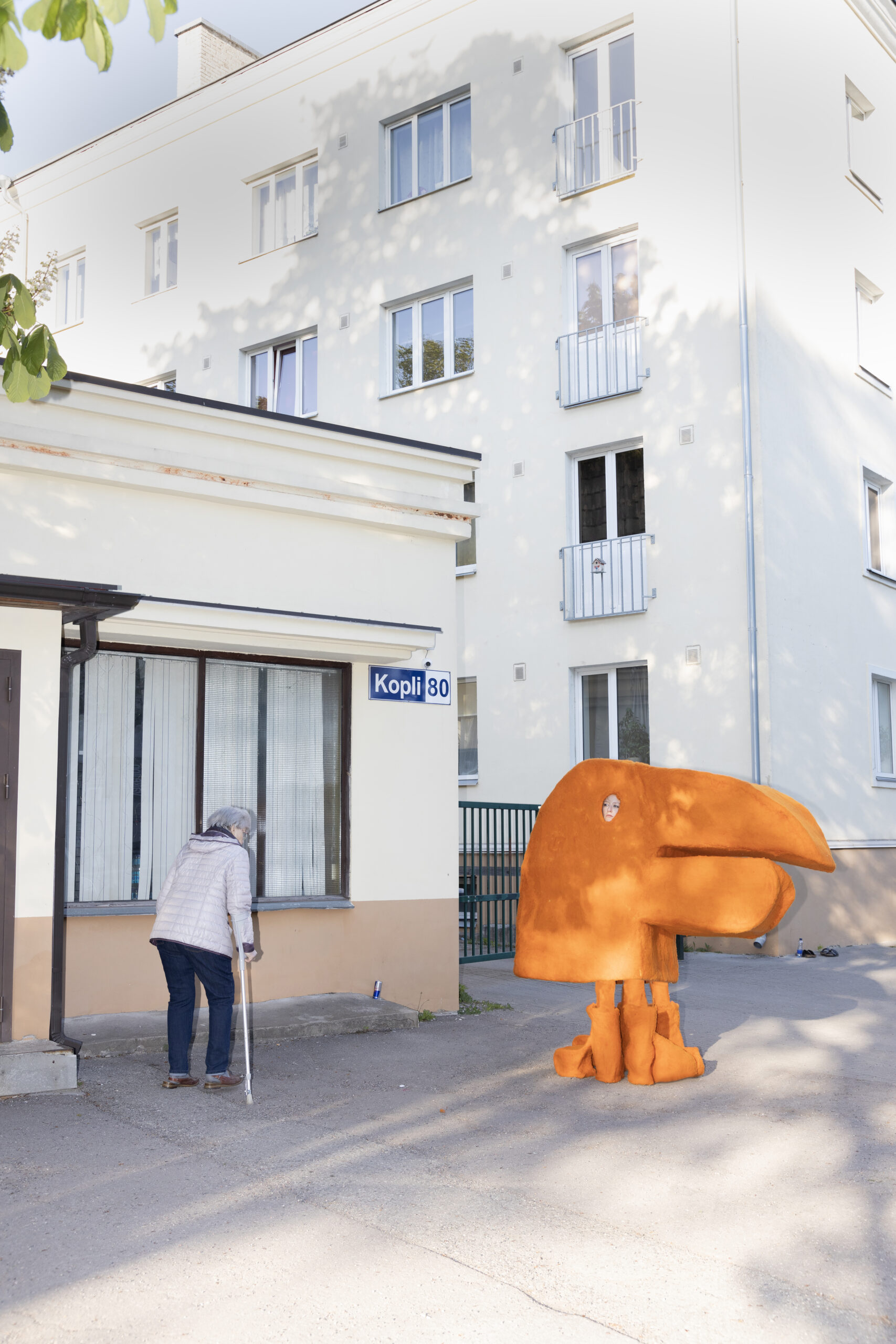
RV: On 25 August 2025, the fashion event Finiśage will take place. It initially started as a response to what ERKI had become, but I wouldn’t describe it that way anymore. Our goal is to bring something fresh and new to the Estonian fashion scene – a format that hasn’t been done here before. We decided to create a platform where we could present our work with dignity because this was not what we had experienced at ERKI. In 2023, I took part in ERKI with my collection Sold My Soul for a Pile of Crap, and this was my last time to participate there. Even the jury evaluation, which took place a few days before the show, was absurd. I had prepared a detailed text explaining the entire concept, the music, and the presentation, but when the jury entered the room, they simply talked amongst themselves and didn’t listen to me at all. After I’d finished, they began asking me about the exact same things I had just explained. I looked at them like are you kidding me or what’s going on here? It felt like you work for a whole year to have two and a half minutes on stage. That’s when the idea started to take root—to create something on our own terms, where everyone could present their work the way they envisioned it, without limitations.
MR: From my one and only time participating in ERKI (2023), I got the impression that, although the feedback was positive, all the immense work and effort didn’t eventually amount to a feeling of any kind of clear and positive outcome. Participants poured their days, nights and health into it, but eventually, all that remained was a sense of emptiness. The jury didn’t take a closer look, didn’t touch the pieces to see how anything was made. Of course, it’s nice that something like ERKI exists because without it, what else would there be? But what’s actually cool about ERKI is what happens on stage. If designers no longer want to bring their work there, then what’s left?
LS: It seems to me that ERKI has become an event where young people invest huge amounts of money and months of work, yet in the end, it doesn’t pay off. At the same time, it remains an important platform – you’re presented with an established format that you can apply to, and if you make it to the stage, you have a solid platform to present your work. But at this point, ERKI has turned into a hub of nasty competition and envy. Should it really be this hyper-professional fashion stage where everything revolves around ruthless rivalry, where you’re expected to feel devastated because one person made it and another didn’t? Or could it be a community event instead?
KJA: For example, there’s no competition at the fashion show of the Antwerp fashion design department. Everybody shows their work there, from first-year students to master’s students. It’s a celebration for the fashion design department, where everyone gets their chance to present their work. And the show ends with all the designers and models coming on stage together to celebrate – it’s a party, it’s fun.
LS: Yes, I really feel like Estonia would benefit more at the moment if ERKI were a celebration for fashion students, and not another competition.
MR: Yes, exactly. And then we decided: why cry about something being done poorly when we could do it well ourselves? We also thought that after doing so much work for all these years, we might as well leave with a big bang. To have a kind of big celebration for ourselves as well.
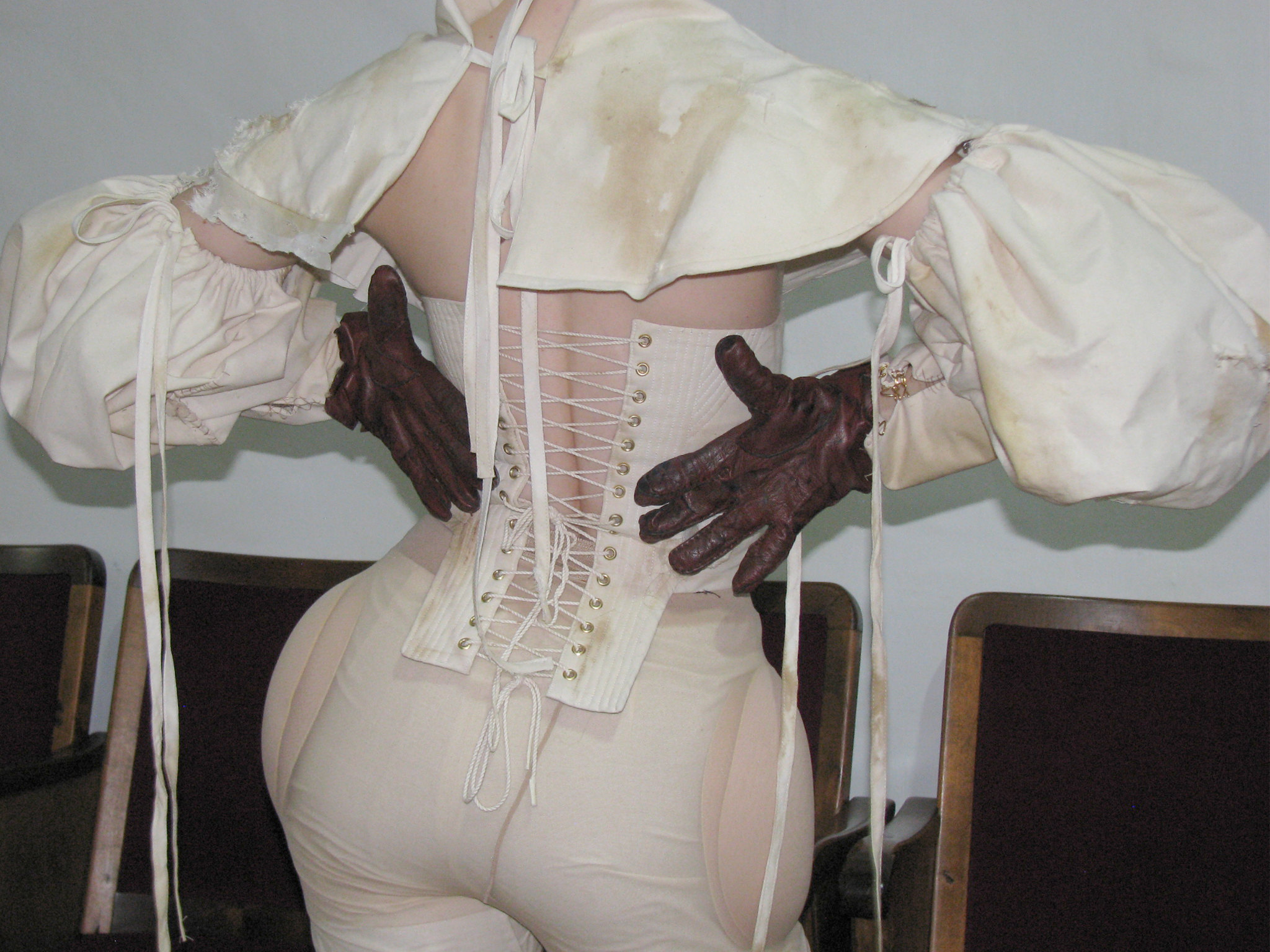
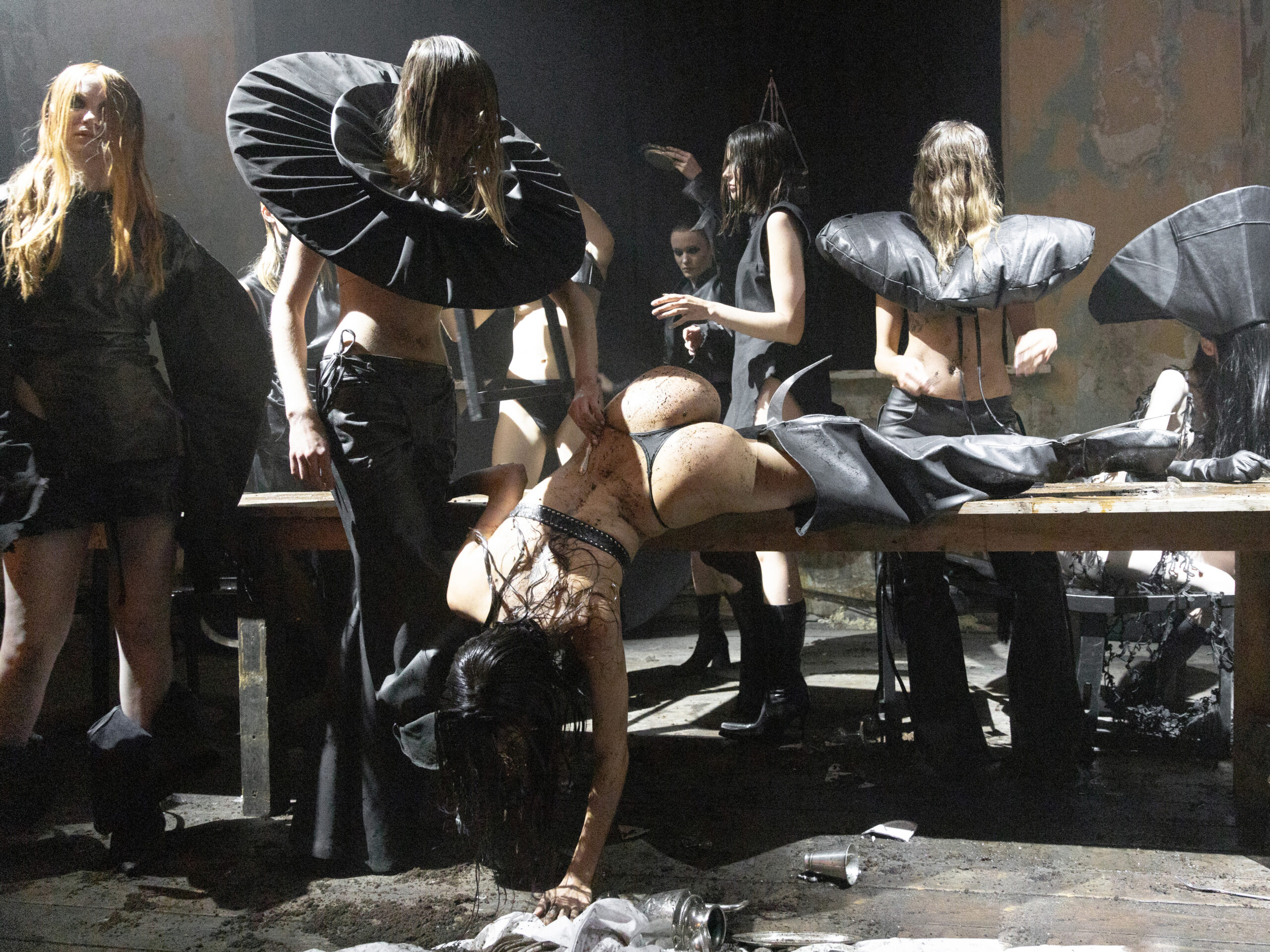
RV: We, as the future, should be more welcoming. Personally, I feel that the generation above us isn’t really letting younger designers in. Instead of paving the way, they seem to be building a wall – as if the next generation didn’t exist at all…
LS: There are two options: either to dream or to be realistic. If we’re dreaming, then I have three suggestions for improving the state of the Estonian fashion scene. First, EKA’s fashion department could admit students only every other year. Second, hire more people in the department and establish separate branches for fashion design and fashion art based on the needs of each course. These wouldn’t have to be separate programmes, but would provide the opportunity for a student to specialise as they prefer. And third, if funding were available somewhere, then fashion design could really use a home. It wouldn’t have to be anything fancy, but without a consistent workspace, fashion as a discipline cannot evolve. So these are my three suggestions. Additionally, I like the idea that every fashion course should have its so-called group supervisor, who would be with the students from the beginning of their studies to the end. That way young designers would have this one safe person, who knows how you’ve developed, what topics you’re interested in, etc.
KJA: Yes, absolutely – students should be accepted only once every two years. And the fashion department should arrange some kind of focus groups or do it so that one year they enrol fashion artists, the next year fashion designers. Besides that, I feel that there’s immense power in the collective and doing things together. This is exactly what makes Ron and Maria’s course so great: they’re working as a group. Hopefully, they’ll have the energy to continue in the future. When people stand together for common goals, they can achieve more and go further.
